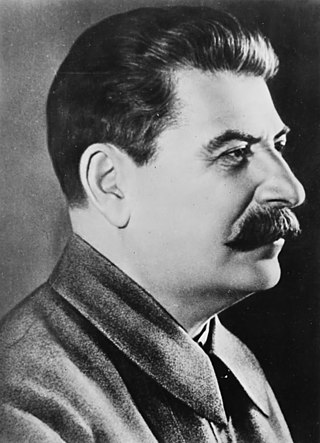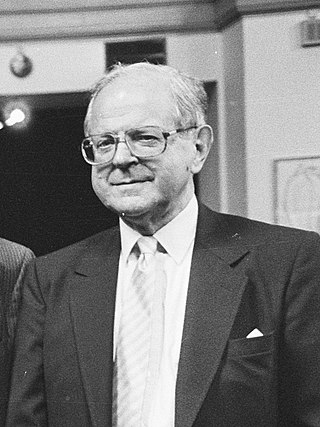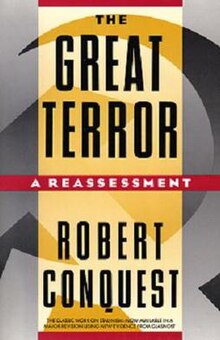
Democide refers to "the intentional killing of an unarmed or disarmed person by government agents acting in their authoritative capacity and pursuant to government policy or high command." The term was first coined by Holocaust historian and statistics expert, R.J. Rummel in his book Death by Government, but has also been described as a better term than genocide to refer to certain types of mass killings, by renowned Holocaust historian Yehuda Bauer. According to Rummel, this definition covers a wide range of deaths, including forced labor and concentration camp victims, extrajudicial summary killings, and mass deaths due to governmental acts of criminal omission and neglect, such as in deliberate famines like the Holodomor, as well as killings by de facto governments, for example, killings during a civil war. This definition covers any murder of any number of persons by any government.

Joseph Vissarionovich Stalin was a Soviet revolutionary and political leader who led the Soviet Union from 1924 until his death in 1953. He held power as General Secretary of the Communist Party of the Soviet Union (1922–1952) and Chairman of the Council of Ministers of the Soviet Union (1941–1953). Initially governing the country as part of a collective leadership, he consolidated power to become a dictator by the 1930s. Ideologically adhering to the Leninist interpretation of Marxism, he formalised these ideas as Marxism–Leninism, while his own policies are called Stalinism.

Stalinism is the means of governing and Marxist–Leninist policies implemented in the Soviet Union (USSR) from 1927 to 1953 by Joseph Stalin. It included the creation of a one-party totalitarian police state, rapid industrialization, the theory of socialism in one country, collectivization of agriculture, intensification of class conflict, a cult of personality, and subordination of the interests of foreign communist parties to those of the Communist Party of the Soviet Union, which Stalinism deemed the leading vanguard party of communist revolution at the time. After Stalin's death and the Khrushchev Thaw, a period of de-Stalinization began in the 1950s and 1960s, which caused the influence of Stalin's ideology to begin to wane in the USSR.

The Gulag Archipelago: An Experiment in Literary Investigation is a three-volume series written between 1958 and 1968 by the Russian writer and Soviet dissident Aleksandr Solzhenitsyn. It was first published in 1973, and it was translated into English and French the following year. It presents a vision of life in what is often known as the Gulag, the Soviet labour camp system, through a narrative which was constructed from various sources including reports, interviews, statements, diaries, legal documents, and Solzhenitsyn's own experience as a Gulag prisoner.

George Robert Acworth Conquest was a British-American historian and poet.

The Great Purge or the Great Terror, also known as the Year of '37 and the Yezhovshchina, was Soviet General Secretary Joseph Stalin's campaign to solidify his power over the Communist Party of the Soviet Union and the state, by removal and execution of people; the purges were also designed to remove the remaining influence of Leon Trotsky as well as other prominent political rivals within the party. It occurred from August 1936 to March 1938.

The Holodomor, also known as the Great Ukrainian Famine, was a man-made famine in Soviet Ukraine from 1932 to 1933 that killed millions of Ukrainians. The Holodomor was part of the wider Soviet famine of 1930–1933 which affected the major grain-producing areas of the Soviet Union.
Soviet and communist studies, or Soviet studies is the field of historical studies of the Soviet Union and other Communist states as well as historical studies of the Communist parties that existed or still exist in some form in many countries, both inside and outside the former Eastern Bloc, such as the Communist Party USA. Aspects of its historiography have attracted debates between historians on topics including totalitarianism and Cold War espionage.
The Ryutin affair (1932) was one of the last attempts to oppose the General Secretary Joseph Stalin within the All-Union Communist Party (b).
Throughout the history of the Soviet Union, tens of millions of people suffered political repression, which was an instrument of the state since the October Revolution. It culminated during the Stalin era, then declined, but it continued to exist during the "Khrushchev Thaw", followed by increased persecution of Soviet dissidents during the Brezhnev era, and it did not cease to exist until late in Mikhail Gorbachev's rule when it was ended in keeping with his policies of glasnost and perestroika.
John Archibald Getty III is an American historian and professor at the University of California, Los Angeles (UCLA), who specializes in the history of Russia and the history of the Soviet Union.
The actions by governments of communist states have been subject to criticism across the political spectrum. Communist party rule has been especially criticized by anti-communists and right-wing critics, but also by other socialists such as anarchists, trotskyists, democratic socialists, libertarian socialists and orthodox marxists. Ruling communist parties have also been challenged by domestic dissent. According to the critics, rule by communist parties has often led to totalitarianism, political repression, restrictions of human rights, poor economic performance, and cultural and artistic censorship.

The Soviet famine of 1930–1933 was a famine in the major grain-producing areas of the Soviet Union, including Ukraine and different parts of Russia, including Northern Caucasus, Kuban Region, Volga Region, Kazakhstan, the South Urals, and West Siberia. Estimates conclude that 5.7 to 8.7 million people died of famine across the Soviet Union. Major contributing factors to the famine include: the forced collectivization of agriculture as a part of the First Five-Year Plan, and forced grain procurement, combined with rapid industrialization and a decreasing agricultural workforce. Sources disagree on the possible role of drought. During this period the Soviet government escalated its persecution against the kulaks. Soviet leader Joseph Stalin had ordered kulaks "to be liquidated as a class", so they became a target for the state. Persecution against the kulaks had been ongoing since the Russian Civil War, and had never fully subsided. Once collectivization became widely implemented, the persecution against the kulaks increased which culminated in a Soviet campaign of political repression, including arrests, deportations, and executions of large numbers of the kulaks in 1929–1932. Some kulaks responded by carrying out acts of sabotage such as killing livestock and destroying crops intended for consumption by factory workers. Despite the death toll mounting, Stalin chose to continue the Five Year Plan and collectivization. By 1934, the Soviet Union established an industrial baseline; however, it did come at the cost of millions of lives.
Communism is a left-wing to far-left sociopolitical, philosophical, and economic ideology within the socialist movement, whose goal is the creation of a communist society, a socioeconomic order centered around common ownership of the means of production, distribution, and exchange that allocates products to everyone in the society based on need. A communist society would entail the absence of private property and social classes, and ultimately money and the state.

Dekulakization was the Soviet campaign of political repressions, including arrests, deportations, or executions of millions of kulaks and their families. Redistribution of farmland started in 1917 and lasted until 1933, but was most active in the 1929–1932 period of the first five-year plan. To facilitate the expropriations of farmland, the Soviet government announced the "liquidation of the kulaks as a class" on 27 December 1929, portraying kulaks as class enemies of the Soviet Union.

Mass killings under communist regimes occurred through a variety of means during the 20th century, including executions, famine, deaths through forced labour, deportation, starvation, and imprisonment. Some of these events have been classified as genocides or crimes against humanity. Other terms have been used to describe these events, including classicide, democide, red holocaust, and politicide. The mass killings have been studied by authors and academics and several of them have postulated the potential causes of these killings along with the factors which were associated with them. Some authors have tabulated a total death toll, consisting of all of the excess deaths which cumulatively occurred under the rule of communist states, but these death toll estimates have been criticized. Most frequently, the states and events which are studied and included in death toll estimates are the Holodomor and the Great Purge in the Soviet Union, the Great Chinese Famine and the Cultural Revolution in the People's Republic of China, and the Cambodian genocide in Democratic Kampuchea.

Kulak, also kurkul or golchomag, was the term which was used to describe peasants who owned over 8 acres of land towards the end of the Russian Empire. In the early Soviet Union, particularly in Soviet Russia and Azerbaijan, kulak became a vague reference to property ownership among peasants who were considered hesitant allies of the Bolshevik Revolution. In Ukraine during 1930–1931, there also existed a term of pidkurkulnyk ; these were considered "sub-kulaks".

The Harvest of Sorrow: Soviet Collectivization and the Terror-Famine is a 1986 book by British historian Robert Conquest published by the Oxford University Press. It was written with the assistance of historian James Mace, a junior fellow at the Harvard Ukrainian Research Institute, who started doing research for the book following the advice of the director of the institute. Conquest wrote the book in order "to register in the public consciousness of the West a knowledge of and feeling for major events, involving millions of people and millions of deaths, which took place within living memory."

Estimates of the number of deaths attributable to the Soviet revolutionary and dictator Joseph Stalin vary widely. The scholarly consensus affirms that archival materials declassified in 1991 contain irrefutable data far superior to sources used prior to 1991 such as statements from emigres and other informants.

Stalin: Breaker of Nations is a biography of Joseph Stalin by author and historian Robert Conquest. It was published in 1991 by Weidenfeld and Nicolson and Penguin Books.













